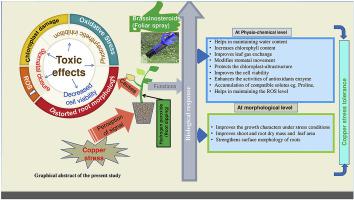Ecotoxicology and Environmental Safety ( IF 6.2 ) Pub Date : 2020-09-11 , DOI: 10.1016/j.ecoenv.2020.111081 Faroza Nazir 1 , Qazi Fariduddin 1 , Anjuman Hussain 1 , Tanveer Alam Khan 2

|
Brassinosteroids and hydrogen peroxide (H2O2) are extensively used to combat several environmental factors, including heavy metal stress in plants, but their cumulative impact on the maintenance of copper (Cu) homeostasis in plants could not be dissected at elevated level. This study was executed to explore the roles of 24-epibrassinolide (EBL; foliar) and H2O2 (root dipping) in resilience of tomato (Solanum lycopersicum L.) plants to Cu stress. The cumulative effect of EBL and H2O2 in tomato plants grown under Cu stress (10 or 100 mg kg−1 soil) were assessed. Roots of 20 d old plants were submerged in 0.1 mM of H2O2 solution for 4 h and subsequently transplanted in the soil-filled earthen pots and at 30 day after transplantation (DAT), the plants were sprinkled with deionized water (control), and/or 10−8 M EBL and plant performances were evaluated at 40 DAT. High Cu (100 mg kg−1 soil) concentration considerably reduced photosynthetic efficacy, cell viability, and plant growth, and deformed chloroplast ultrastructure and root morphology with altered stomatal behavior, but boosted the activity of antioxidant enzymes, proline content and electrolyte leakage in the leaves of tomato. Moreover, EBL and H2O2 implemented through distinct modes improved photosynthetic efficiency, modified chloroplast ultrastructure, stomatal behavior, root structure, cell viability and production of antioxidants and proline (osmolyte) that augmented resilience of tomato plants to Cu stress. This study revealed the potential of EBL and H2O2 applied through distinct mode could serve as an effective strategy to reduce Cu-toxicity in tomato crop.
中文翻译:

油菜素类固醇和过氧化氢可改善光合作用,气孔运动,根系形态和细胞活力,并减少铜触发的番茄氧化爆发。
油菜素类固醇和过氧化氢(H 2 O 2)被广泛用于抵抗多种环境因素,包括植物中的重金属胁迫,但是它们对维持植物体内铜(Cu)稳态的累积影响无法在较高水平下进行剖析。进行这项研究以探索24-表油菜素内酯(EBL;叶面)和H 2 O 2(根浸)在番茄(茄属植物)对铜胁迫的抗逆性中的作用。评估了EBL和H 2 O 2在铜胁迫下(10或100 mg kg -1土壤)生长的番茄植株的累积效应。将20 d老植物的根浸在0.1 mM H 2中O 2溶液处理4 h,然后移植到装满土的土盆中,并在移植后30天(DAT),向植物撒上去离子水(对照),和/或10 -8 M EBL,评估植物性能在40 DAT。高浓度的Cu(100 mg kg -1土壤)浓度会大大降低光合作用,细胞活力和植物生长,并改变叶绿体超微结构和根系形态,并改变气孔行为,但会增加抗氧化酶的活性,脯氨酸含量和电解质的泄漏。番茄的叶子。此外,EBL和H 2 O 2通过不同的模式实施,可提高光合作用效率,改善叶绿体超微结构,气孔行为,根系结构,细胞活力以及产生抗氧化剂和脯氨酸(渗透压),从而增强番茄植物对铜胁迫的适应力。这项研究表明,通过不同模式施用EBL和H 2 O 2的潜力可以作为降低番茄作物中Cu毒性的有效策略。









































 京公网安备 11010802027423号
京公网安备 11010802027423号